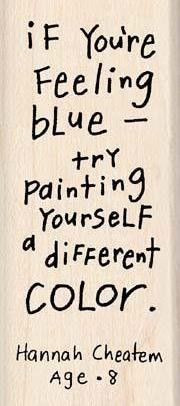NLP Submodalities Made Simple
Submodalities in NLP can have a big impact on how you react to the world around you. “If you are feeling blue – try painting yourself a different color” …NLP Submodalities Made Simple for sure. It really can be that simple when you learn to pay attention to your submodalities (how you code your reality) and change what isn’t working for you.
Feeling Blue – Try Painting Yourself A Different Color
First it is important to know what are Modalities in order to under how to change submodalities. Modalities are Visual (pictures or images), Auditory (words, sounds) Kinesthetic (feelings -internal emotions or external touch etc) smell and taste.
Submodalities are the finer distinctions of each modality.
Let’s take Visual for example. Visual submodalites would be whether the image in your mind is near or far, in color or black and white, in focus or out of focus etc.
Auditory submodalities could be the quality of the sounds or voice you hear. It also could be near or far, loud or soft, high pitch or deep base, fast or slow etc.
The same goes for Kinesthetic, feelings could be location in the body. You may have said to yourself things like “when I talk to my boss my stomach is in knots”….or anything like that. You are describing your submodalites of your feelings in your stomach. If you pay closer attention, you will be able to notice what direction the feeling is moving and perhaps even the visual representation of the feeling you have.
We teach submodalites in depth on our NLP Training Online along with many techniques on how to use submodalites to change how to view situations differently and how to change your reactions to bad situations.
Hannah, the 8 year old, unconsciously knew she could change the way she felt by changing the submodalites of how she coded her reality. It really is simple when you know how.
3 Easy Steps to Change Your Submodalities to A Bad Situation
1. Pay attention to the representation of how you see, hear or feeling the situation
2. Write down the submodalities of this situation
3. One-by-one, change how you see the situation to another submodality example: if it is near…make it far….if it is clear….make it fuzzy or out of focus etc. Do the same for auditory and kinesthetic submodalities.
Notice how you feel as you change the submodalites to the situation. The one submodality that has the biggest impact on you is known as the driver; when you change it, the others change automatically.


